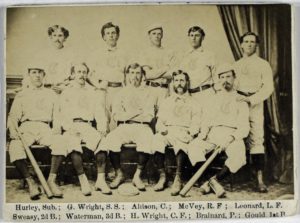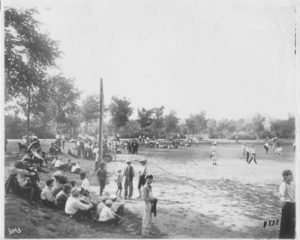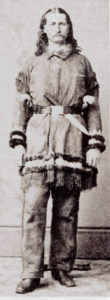WCAG Heading
by Tom Clavin
With Major League Baseball emerging from its winter slumber, fans tend to acknowledge what anniversaries the new season brings us. In 2019, it was the centennial of the infamous Black Sox scandal, when gangsters fixed the outcome of the World Series. It was the 50th anniversary of the Miracle Mets, when what had been the worst team in baseball defeated the might Baltimore Orioles for the world championship. And it was the 150th anniversary of Wild Bill Hickok as a baseball umpire.
What?

Okay, okay, most baseball aficionados will insist that this year is the 150th anniversary of the Cincinnati Red Stockings, which in 1869 were the sport’s first openly all-professional team, with 10 salaried players. Initially, the Cincinnati Base Ball Club had been formed three years earlier and fielded competitive teams in the National Association of Base Ball Players in the 1867 to 1869 period, a time of transition after the Civil War. Thanks partly to their on-field success and the continental scope of their tours, the Red Stockings established styles in team uniforms and team nicknames that have some currency even in the 21st century. They also established a particular color, red, as the color of Cincinnati, and they provide the ultimate origin for the use of “Red Sox” in Boston. In 1869, they had those salaried players and went on a national barnstorming tour that established baseball as the national pastime.

But one of the lesser-known exploits of James Butler Hickok, known as Wild Bill, at this time was on a baseball diamond. In Kansas City was a ballfield at the corner of Fourteenth and Oak Streets. This was the home of the Kansas City Antelopes, the first baseball team in the city. It had been organized by the attorney D.S. Twitchell in July 1866, three years before the Cincinnati Red Legs achieved their fame. The Antelopes park had no grandstand or scoreboard and patrons had to sit on benches in the hot sun. Still, every Saturday afternoon people filed in to watch this new sport. One of the spectators, when he was in town, was Hickok. He played pick-up games with local youngsters before games, and one Saturday, he was asked to umpire an Antelopes game.
The reason Wild Bill, of all people, was asked was because the weekly contests had a habit of descending into brawls, especially if the umpire ruled on a play against the Antelopes. There was no gunplay – guns weren’t allowed within the Kansas City limits – but fists, boots, bottles, and even the occasional knife were employed to dispute the call with fans of the visiting team and the cowering umpire. On this particular Saturday in 1869, the Antelopes were hosting the Atchison Pomeroys. The visitors had beaten the Antelopes on their home turf and an attempt at a rematch in Kansas City had resulted in a riot and the game was canceled. “The Town Is Disgraced!” blared a headline in the Kansas City Star.
 A rematch of the rematch was arranged. Hickok agreed to be the umpire, and when the first pitch was thrown, he was behind the plate with what passed for umpire’s gear then. Hickok also wore, thanks to a dispensation from the city fathers, his Colt six-shooters.
A rematch of the rematch was arranged. Hickok agreed to be the umpire, and when the first pitch was thrown, he was behind the plate with what passed for umpire’s gear then. Hickok also wore, thanks to a dispensation from the city fathers, his Colt six-shooters.
The game was played to its completion, and the pleased crowd cheered the 48-28 victory by the Antelopes. (Pitches were tossed underhand, making the ball easier to hit.) They cheered the umpire too, who bowed to acknowledge the approval, then made his way to Market Square to take up that night’s gambling entertainment.
Yes, Wild Bill Hickok was known for being the first gunfighter on the American frontier and he was the prototype of the Wild West lawman, but one summer he was the most famous baseball “player” on the field.
Tom Clavin is a #1 New York Times bestselling author and has worked as a newspaper and web site editor, magazine writer, TV and radio commentator, and a reporter for The New York Times. He has received awards from the Society of Professional Journalists, Marine Corps Heritage Foundation, and National Newspaper Association. His books include The Heart of Everything That Is, Halsey’s Typhoon, and Reckless. He lives in Sag Harbor, NY.
